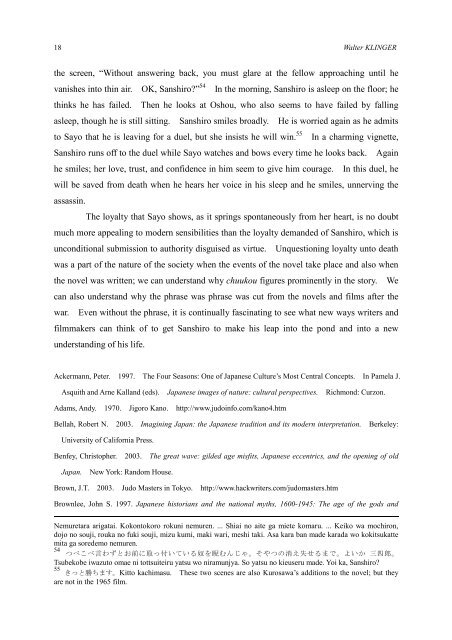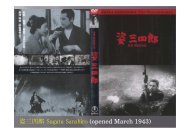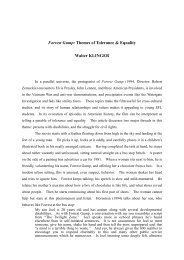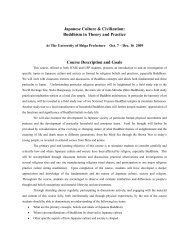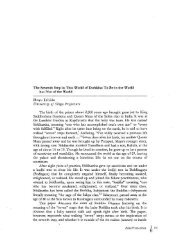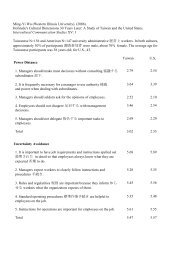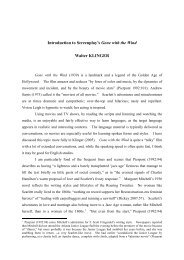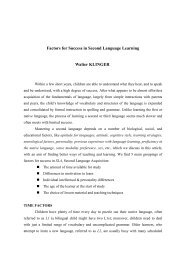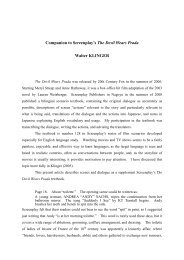Create successful ePaper yourself
Turn your PDF publications into a flip-book with our unique Google optimized e-Paper software.
18 <strong>Walter</strong> <strong>KLINGER</strong>the screen, “Without answering back, you must glare at the fellow approaching until hevanishes into thin air. OK, Sanshiro?” 54 In the morning, Sanshiro is asleep on the floor; hethinks he has failed. Then he looks at Oshou, who also seems to have failed by fallingasleep, though he is still sitting. Sanshiro smiles broadly. He is worried again as he admitsto Sayo that he is leaving for a duel, but she insists he will win. 55 In a charming vignette,Sanshiro runs off to the duel while Sayo watches and bows every time he looks back. Againhe smiles; her love, trust, and confidence in him seem to give him courage. In this duel, hewill be saved from death when he hears her voice in his sleep and he smiles, unnerving theassassin.The loyalty that Sayo shows, as it springs spontaneously from her heart, is no doubtmuch more appealing to modern sensibilities than the loyalty demanded of Sanshiro, which isunconditional submission to authority disguised as virtue. Unquestioning loyalty unto deathwas a part of the nature of the society when the events of the novel take place and also whenthe novel was written; we can understand why chuukou figures prominently in the story. Wecan also understand why the phrase was phrase was cut from the novels and films after thewar. Even without the phrase, it is continually fascinating to see what new ways writers andfilmmakers can think of to get Sanshiro to make his leap into the pond and into a newunderstanding of his life.Ackermann, Peter. 1997. The Four Seasons: One of Japanese Culture’s Most Central Concepts. In Pamela J.Asquith and Arne Kalland (eds). Japanese images of nature: cultural perspectives. Richmond: Curzon.Adams, Andy. 1970. Jigoro Kano. http://www.judoinfo.com/kano4.htmBellah, Robert N. 2003. Imagining Japan: the Japanese tradition and its modern interpretation. Berkeley:University of California Press.Benfey, Christopher.2003. The great wave: gilded age misfits, Japanese eccentrics, and the opening of oldJapan.New York: Random House.Brown, J.T. 2003. Judo Masters in Tokyo. http://www.hackwriters.com/judomasters.htmBrownlee, John S. 1997. Japanese historians and the national myths, 1600-1945: The age of the gods andNemuretara arigatai. Kokontokoro rokuni nemuren. ... Shiai no aite ga miete komaru. ... Keiko wa mochiron,dojo no souji, rouka no fuki souji, mizu kumi, maki wari, meshi taki. Asa kara ban made karada wo kokitsukattemita ga soredemo nemuren.54 つべこべ 言 わわずとお 前 に 取 っ 付 いている 奴 を 睨睍 むんじゃ。そやつの 消 え 失 せるまで。よいか 三 四 郎 。Tsubekobe iwazuto omae ni tottsuiteiru yatsu wo niramunjya. So yatsu no kieuseru made. Yoi ka, Sanshiro?55 きっと 勝 ちます。Kitto kachimasu. These two scenes are also Kurosawa’s additions to the novel; but theyare not in the 1965 film.


